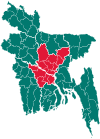Manikgonj Sadar
মানিকগঞ্জ সদর | |
|---|---|
 Madrasa Darul Uloom Manikganj | |
 | |
| Coordinates: 23°51′N 90°0.7′E / 23.850°N 90.0117°E | |
| Country | |
| Division | Dhaka |
| District | Manikganj |
| Headquarters | Manikganj |
| Area | |
| • Total | 214.81 km2 (82.94 sq mi) |
| Population (2011) | |
| • Total | 309,413 |
| • Density | 1,400/km2 (3,700/sq mi) |
| Time zone | UTC+6 (BST) |
| Website | Official Map of Manikganj Sadar |
Manikgonj Sadar (Bengali: মানিকগঞ্জ সদর) is an upazila of Manikgonj District[1] in the division of Dhaka, Bangladesh.
Geography
[edit]Manikgonj Sadar is located at 23°51′00″N 90°00′40″E / 23.8500°N 90.0111°E. It has a total area of 214.81 km2.
Demographics
[edit]| Year | Pop. (000) | ±% |
|---|---|---|
| 1981 | 209 | — |
| 1991 | 237 | +13.4% |
| 2001 | 262 | +10.5% |
| 2011 | 309 | +17.9% |
| 2022 | 364 | +17.8% |
| Source: Bangladesh Bureau of Statistics[2] | ||
At the 2011 Bangladesh census, Manikganj Sadar Upazila had 71,202 households and a population of 309,413. Out of the total, 61,587 inhabitants (19.90%) were under 10 years of age. Manikganj Sadar had a literacy rate (age 7 and over) of 56.01%, compared to the national average of 51.8%, and a sex ratio of 1071 females per 1000 males. 72,108 (23.30%) lived in urban areas.[2][3]
Sports
[edit]Manikganj Stadium is located by the Manikganj public library, Manikganj, Bangladesh.
Administration
[edit]Manikganj Sadar Upazila is divided into Manikganj Municipality and ten union parishads: Atigram, Bhararia, Betila-Mitra, Dighi Union, Garpara, Hatipara, Jagir, Krishnapur, Nabagram, Putail. The union parishads are subdivided into 270 mauzas and 315 villages.[2]
Manikganj Municipality is subdivided into 9 wards and 50 mahallas.[2]
Education
[edit]Educational institutions include:-
- Colonel Malek Medical College
- Government Debendra College
- Government Textile Vocational Institute Manikganj
- Madrasa Darul Ulum Manikganj
- Manikganj Govt. High School
- Manikganj Medical College
- NPI University of Bangladesh
- Rajibpur high school
- Rajibpur adarsha college
- B.K.G high school
- Atigram A.c. High School
- Itqan International School
- Hatipara High School
- S.K. Govt. Girls High School Manikganj
- Muljan High School, Manikganj
See also
[edit]References
[edit]- ^ MA Ramzan (2012), "Manikganj Sadar Upazila", in Sirajul Islam and Ahmed A. Jamal (ed.), Banglapedia: National Encyclopedia of Bangladesh (Second ed.), Asiatic Society of Bangladesh
- ^ a b c d e "Bangladesh Population and Housing Census 2011 Zila Report – Manikganj" (PDF). bbs.gov.bd. Bangladesh Bureau of Statistics.
- ^ "Community Tables: Manikganj district" (PDF). bbs.gov.bd. 2011.

Well, that’s interesting to know that Psilotum nudum are known as whisk ferns. Psilotum nudum is the commoner species of the two. While the P. flaccidum is a rare species and is found in the tropical islands. Both the species are usually epiphytic in habit and grow upon tree ferns. These species may also be terrestrial and grow in humus or in the crevices of the rocks.
View the detailed Guide of Psilotum nudum: Detailed Study Of Psilotum Nudum (Whisk Fern), Classification, Anatomy, Reproduction